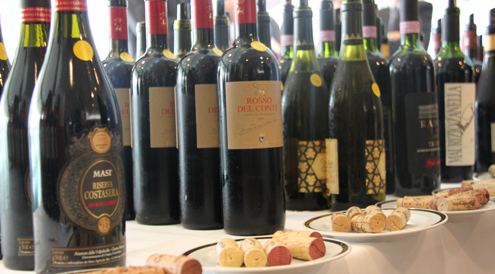
I was invited this week to speak at a luxury market conference in Florence called the Milano Fashion Global Summit, now in its 10th year. For the first time, I thought more about what I should wear versus what wines might be poured. How can one not be self-conscious when you are surrounded by heads of fashion houses, like Patrizio di Marco, Chairman of Gucci and Michele Norsa, CEO of Ferragamo? The theme of this year’s summit was ‘Options of Luxury – the Voice of China’. There were speakers from the non-fashion world like Davide Traxler, CEO of Chopard Italy and Albiero Antinori, Vice Chairman of Marchesi Antinori. Since my presentation was about the link between wine and luxury and specifically Italian wine with China, I spent some time pouring over KPMG, Bain and McKinsey luxury market reports as well as the latest figures about how Italian wines are doing in the market place. The more I read and researched about the link between Italy and China, the more I found. I should not be talking about building bridges between these two countries but rather dusting off and discovering ones that have been built centuries before. Two thousand years ago, the greatest, most advanced civilisations were the Roman empire and the Chinese empire during the Han Dynasty (206 BC to 220 BC). It was this far back that the 2 greatest powers of the world began to know each other and they built bridges, very long ones that spanned across west China, eastern Europe and the Middle East. This route came to be known as the Silk Road. From Xian, the then capital of China, Emperor Qin Shi Huang who constructed the terracotta soldiers, encouraged the trading routes that led to the Mediterrranean Sea and to Rome. Of course there is Marco Polo who spent 17 years travelling throughout China during the Yuan Dynasty when the Mongolian Kublai Khan was in power. His descriptions of China during the 13th century still serve as historical reference points. The Italian who is less celebrated, but has contributed much to the Italian-Chinese relationship, is Mateo Ricci. He was a Jesuit priest who arrived in China in 1583 during the Ming Dynasty to convert Chinese to Christianity. Ricci was open minded, friendly & respectful and introduced clocks and sundials as well as western mathematics, astronomy and geography. He is credited with publishing the first maps of China. Ricci lived in China for 27 years and paved the way for other Italians to establish links with China. Fast-forward to modern times and the road to China is far more complicated than the ancient Silk Road routes. With China closed to the world during the Mao era, an entire generation or two have forgotten the old ties between Italy and China. Recently, Italian producers seem to be waking up to the reality that they may be getting left behind in the fierce race for pieces of the Chinese wine market pie. In Hong Kong the Gelardini & Romani auction held last month of all Italian wines was 94% sold with many of the wines like Masseto going for above the high estimates. Not bad during a time when other auctions are struggling to achieve results of 90% sold. The luxury market in China is growing and the Milano Fashion Global Summit brought together top Italian fashion houses that announced plans for expansion. Ferragamo currently has 58 stores in China while Gucci has 45. The numbers sound impressive but Gucci Chairman, Patrizio di Marco, said, “We are doing only 5% of what we could be doing in China. We need to do more and to react faster to the market demand.” I think we can expect to see a lot more Gucci shops in China. The majority shareholder behind Gucci is the self-made billionaire Francois Pinault. His daughter Florence Pinault is president of Chateau Latour yet the two big companies have not often been associated together. Ferragamo family purchased Il Borro, an estate and vineyard area that is also the name of their wine. Here, fashion and wine mix together fluidly with Salvatore Ferragamo, the grandson of the founder of the famous designer, promoting their wines around the world. In France, the ties with fashion and wine are equally strong: Chanel and Chateau Rauzan Segla, Hermes and Chateau Forcas Hosten and of course Bernard Arnault with his fashion and wine empire under the LVMH group. These chateaux are discovering that the fashion world and the wine world have many overlaps. For the 2009 vintage, Karl Lagerfeld (designer for Chanel) created the Rauzan Segla label. Listening to the speakers from the fashion world talk about their incredible expansion plans in China, I could see the potential of Italian wines if they could follow in the same path. Wine companies tied to fashion houses should co-market together. Many of the customers for Gucci and Ferragamo are women and this is one untapped market in China. Bringing wine into the marketing strategy would deliver a stronger lifestyle message. Plus it would boost the sex appeal of the wines, which could surely use the help. Getting customers to buy quality merchandise is the easy part, getting them to be loyal to the brand is the more challenging issue. Incorporating wine and food and presenting it as a holistic lifestyle package may be the way to go. Selling goods is simple, conquering their hearts must be done through experience and memories. What better way than with food and wine?
Reprinted with permission from South China Morning Post









